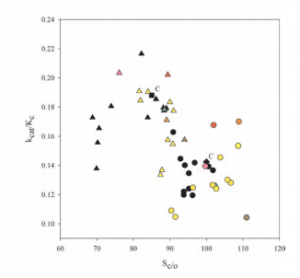DOI: 10.1093/jxb/erv574
Rubisco catalytic properties of wild and domesticated relatives provide scope for improving wheat photosynthesis
Abstract
 Rubisco is a major target for improving crop photosynthesis and yield, yet natural diversity in catalytic properties of this enzyme is poorly understood. Rubisco from 25 genotypes of the Triticeae tribe, including wild relatives of bread wheat (Triticum aestivum), were surveyed to identify superior enzymes for improving photosynthesis in this crop. In vitro Rubisco carboxylation velocity (Vc), Michaelis–Menten constants for CO2 (Kc) and O2 (Ko) and specificity factor (Sc/o) were measured at 25 and 35 °C. Vc and Kc correlated positively, while Vc and Sc/o were inversely related. Rubisco large subunit genes (rbcL) were sequenced, and predicted corresponding amino acid differences analysed in relation to the corresponding catalytic properties. The effect of replacing native wheat Rubisco with counterparts from closely related species was analysed by modelling the response of photosynthesis to varying CO2 concentrations. The model predicted that two Rubisco enzymes would increase photosynthetic performance at 25 °C while only one of these also increased photosynthesis at 35 °C. Thus, under otherwise identical conditions, catalytic variation in the Rubiscos analysed is predicted to improve photosynthetic rates at physiological CO2 concentrations. Naturally occurring Rubiscos with superior properties amongst the Triticeae tribe can be exploited to improve wheat photosynthesis and crop productivity.
Rubisco is a major target for improving crop photosynthesis and yield, yet natural diversity in catalytic properties of this enzyme is poorly understood. Rubisco from 25 genotypes of the Triticeae tribe, including wild relatives of bread wheat (Triticum aestivum), were surveyed to identify superior enzymes for improving photosynthesis in this crop. In vitro Rubisco carboxylation velocity (Vc), Michaelis–Menten constants for CO2 (Kc) and O2 (Ko) and specificity factor (Sc/o) were measured at 25 and 35 °C. Vc and Kc correlated positively, while Vc and Sc/o were inversely related. Rubisco large subunit genes (rbcL) were sequenced, and predicted corresponding amino acid differences analysed in relation to the corresponding catalytic properties. The effect of replacing native wheat Rubisco with counterparts from closely related species was analysed by modelling the response of photosynthesis to varying CO2 concentrations. The model predicted that two Rubisco enzymes would increase photosynthetic performance at 25 °C while only one of these also increased photosynthesis at 35 °C. Thus, under otherwise identical conditions, catalytic variation in the Rubiscos analysed is predicted to improve photosynthetic rates at physiological CO2 concentrations. Naturally occurring Rubiscos with superior properties amongst the Triticeae tribe can be exploited to improve wheat photosynthesis and crop productivity.
Key words: Aegilops, barley, carboxylation, enzyme kinetics, photosynthesis, Rubisco, Triticeae, Triticum
